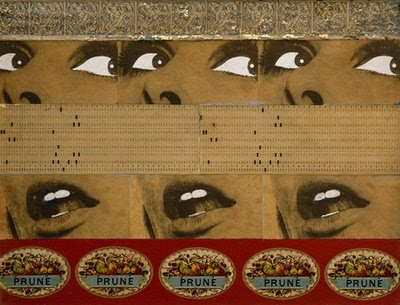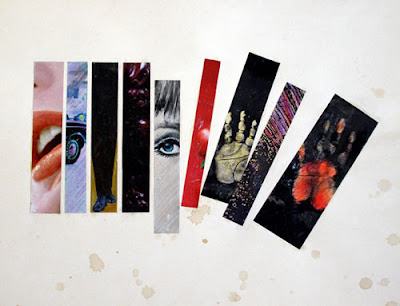 I traveled to Barcelona a few weeks ago, ready to marvel at its plentiful Gaudi architecture and picturesque beach landscape. I did those things, but my favorite part of the trip was a visit to the Museu d'Art Contemporani de Barcelona, a beautiful contemporary art museum. The building is bright and open, and very suited stylistically for forward-thinking newer artists. It doesn't have a large permanent collection, but has space enough to house several temporary exhibitions at once. While I was there three exhibits were on view:
I traveled to Barcelona a few weeks ago, ready to marvel at its plentiful Gaudi architecture and picturesque beach landscape. I did those things, but my favorite part of the trip was a visit to the Museu d'Art Contemporani de Barcelona, a beautiful contemporary art museum. The building is bright and open, and very suited stylistically for forward-thinking newer artists. It doesn't have a large permanent collection, but has space enough to house several temporary exhibitions at once. While I was there three exhibits were on view:
Thomas Bayrle: I've a Feeling We're Not in Kansas Anymore
I wasn't a huge fan of German artist Thomas Bayrle. Most of his works incorporated repeated small images in an op-art style to create one unified image, often with a two- or three-tone color scheme. He also did several series relating to cars and highways. Much of his figural work was overly-pornographic. The pieces I liked most were his kinetic paintings, which involved string- or -rod-operated figures moving back and forth in wooden frames. I also enjoyed the room installation Jacke Wie Hose and M-Formation, with interlocked bits of brightly colored clothing repeated throughout a small room's walls, meeting with the M shapes sprawled across the floor. Otherwise, not much stuck out to me here.




Rabascall: Production 1964-1982
I really enjoyed Joan Rabascall's exhibition, chronologically collecting a large number of collages, photographs, and mixed media works. A lot of his work involved tweaking advertisements or news articles to produce humorous composite images or ambiguous pictorial stories. As one might expect from of the 60's and 70's, many of the pieces lingered on photos of the sexualized female form, sometimes in a "women's bodies are exploited in advertising" way and sometimes in a "women of this age love being naked and free" way. Others spoke to the violent tendencies of the age as well as technological advancements.



 The second part of the show, featuring a large group of small collages from the "Spain is Different" series (1973-1977) as well as the politically-minded film Elecciones Show, was interesting but very much over my head. I admittedly know very little about Spanish history and could not fully appreciate these pieces due to my ignorance. Most of them fused idealistic tourism advertisements with the reality of its then-fascist government.
The second part of the show, featuring a large group of small collages from the "Spain is Different" series (1973-1977) as well as the politically-minded film Elecciones Show, was interesting but very much over my head. I admittedly know very little about Spanish history and could not fully appreciate these pieces due to my ignorance. Most of them fused idealistic tourism advertisements with the reality of its then-fascist government.
Cildo Meireles
The third and final exhibition spotlighted contemporary Brazilian artist Cildo Meireles. His work is highly conceptual, resulting in large-scale installations and ambiguous sculptures, though several small drawings and objects were also shown.
 Eureka/Blindhotland (1970-75) is a room-sized space encompassed by black netting, with small, heavy balls covering the floor and a scale in the middle holding wooden shapes: two rectangles and an X, questioning if the two shapes are heavier separated or connected. Inside, it had an odd sense of quiet, and I felt somehow intrusive breaking the silence by clacking around several of the balls.
Eureka/Blindhotland (1970-75) is a room-sized space encompassed by black netting, with small, heavy balls covering the floor and a scale in the middle holding wooden shapes: two rectangles and an X, questioning if the two shapes are heavier separated or connected. Inside, it had an odd sense of quiet, and I felt somehow intrusive breaking the silence by clacking around several of the balls. Virtual Spaces: Corners filled an entire room with drawings of corners as well as a sculptural representation of them, highlighting his seeming obsession with the subject and furthering his examination of spatial constructs.
Virtual Spaces: Corners filled an entire room with drawings of corners as well as a sculptural representation of them, highlighting his seeming obsession with the subject and furthering his examination of spatial constructs. Glovetrotter (1991) involved a mesh/chainmail-like material sprawled across one room's floor over several balls of different sizes and colors, creating a mini metallic landscape in which everything feels beyond reach.
Glovetrotter (1991) involved a mesh/chainmail-like material sprawled across one room's floor over several balls of different sizes and colors, creating a mini metallic landscape in which everything feels beyond reach. My favorite was Através (Through) (1983): I had to sign a waiver to enter! That alone made it the best experience of the day. It's a room-size installation with several levels of different kinds of barriers- fences, glass, barbed wire, shower curtains- and a layer of broken glass on the floor. In the middle of the maze-like setup is a large cellophane ball with a light emanating from within. The whole piece is a wonderful exploration of tactile surfaces and the different uses of transparent and translucent materials and their ability to be welcoming or upsetting. It was really interesting, and one of the few times I've been a part of a such a large-scale interactive piece.
My favorite was Através (Through) (1983): I had to sign a waiver to enter! That alone made it the best experience of the day. It's a room-size installation with several levels of different kinds of barriers- fences, glass, barbed wire, shower curtains- and a layer of broken glass on the floor. In the middle of the maze-like setup is a large cellophane ball with a light emanating from within. The whole piece is a wonderful exploration of tactile surfaces and the different uses of transparent and translucent materials and their ability to be welcoming or upsetting. It was really interesting, and one of the few times I've been a part of a such a large-scale interactive piece.Overall I really enjoyed this museum, and I hope I'll be able to go back again some time. Unfortunately these exhibits all ended shortly after I saw them, but I would recommend the Museu d'Art Contemporani de Barcelona to anyone visiting the city. Also, their store is phenomenal and very well-priced.


No comments:
Post a Comment